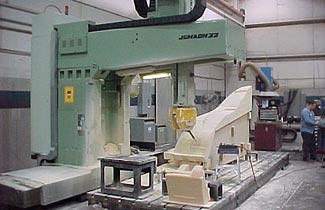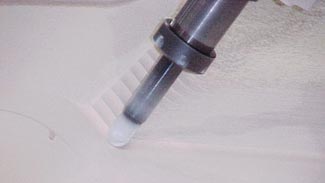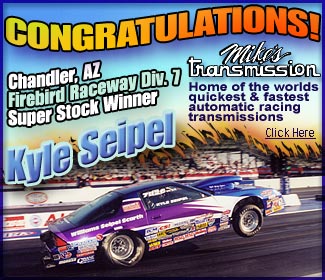|
<<
PREVIOUS PAGE
| A five-axis CNC mill is cutting
a foam buck for the first Stratus carbon
fiber female mold. |
 |
 |
The mill is performing the
finish cut on the foam model for the first
Stratus carbon fiber female mold. The mold
itself is constructed from fiberglass and
epoxy and is assembled and supported by
a large steel skeleton. |
Once completed, the final version was put on
a chassis and shipped up to NRC's full-size
tunnel in Ottawa, Canada for final testing.
"The funny car wants to move around," says
DeKoninck, "they want to use an extra 20 feet
of every 1320-foot length, so we worked hard
at getting the Stratus to stay stuck to the
racing surface. We worked hardest on the downforce
-- in the front so the driver could steer it,
and in the rear to prevent tire spin and maintain
stability."
Happy with the final numbers, the factory-designed
bodies ended up on the Don Schumacher entries
of Whit Bazemore and Gary Scelzi for 2003. Bazemore
has taken his
ADVERTISEMENT
 |
|
Lee
Beard-tuned machine to three finals as of this
date, including winning at Englishtown (which
was also the place where Scelzi posted the unofficial
fastest speed in history at 326.95). The factory,
which used CATIA in their NASCAR design efforts
as well, is certainly hoping that Bazemore and
Scelzi will be able to help dethrone John Force's
decade-long preeminence on the fuel coupe throne.
Like the Avenger the funny car was based on,
the two-door Neon being used in Pro Stock was
no longer available off the showroom floor.
Obviously, Detroit uses racing to drive customers
toward their showrooms, so, not having products
to accommodate those efforts is self-defeating.
Dodge Marketing again wanted the Stratus R/T
coupe instead, and DeKoninck and the crew (from
Dodge and Applied Technologies in Toledo, Ohio)
were turned loose on CATIA again.
This time, since the OE vehicle had been stylized
in the program, it was a simple matter of taking
the surface files in the system and beginning
to modify them for the Pro Stock effort. The
biggest difference was that the Stratus has
more frontal area and is a bigger car than the
Neon; it would need to be massaged to make sure
it could equal the efforts of the previous car
(one that had held the NHRA speed record for
over a year).
To ensure they "colored inside the lines,"
Dodge Motorsports Engineering also began conferring
on a regular basis with NHRA technical staff
to make sure the finished car would be legal
out of the box.
"They saw the 3D drawings (one of CATIAs functions),
the redesigns, and the wind tunnel data," recalls
DeKoninck. "They were very helpful. This Stratus
will fit every template they currently use,
and meets every dimension they require on the
tech sheet."
NEXT
PAGE >>
|